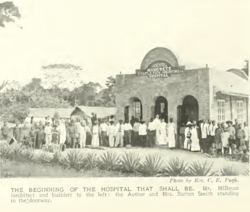Yakusu
| Yakusu | |
|---|---|
|
Mission members in front of early hospital buildings, c. 1909 | |
 Yakusu | |
| Coordinates: 0°34′14″N 25°01′23″E / 0.570609°N 25.023095°ECoordinates: 0°34′14″N 25°01′23″E / 0.570609°N 25.023095°E | |
| Country | Democratic Republic of Congo |
| Province | Orientale Province |
| District | Tshopo District |
| Climate | Af |
Yakusu was a mission in the Democratic Republic of the Congo, on the Congo River just west and downstream of Kisangani.
History
The Baptist Missionary Society mission was established between 1895 and 1896 at the highest navigable point of the Congo, just below the Stanley Falls.[1] The Stanley Falls zone consisted of strips of land 20 kilometres (12 mi) deep along both banks of the Congo between Stanley Falls and Isangi. It was declared a free trade zone, where the state abandoned its interests to private enterprise.[2] The people of the region included the Lokele, Turumbu, Bakumu, Wagenya, Bamanga and Tovoke.[3]
The mission embarked on a program of educating local people, who in turn became teachers in village schools. With high demand, often the education of the teachers had to be rushed.[4] By 1905 the mission had 3,200 pupils at 70 rural schools in the zone. Initially, the mission was on good terms with the authorities. However, as their influence grew there were rumours that the British planned to take over the region. In January 1907 the governor-general Albert Lantonnois ordered the district commissioner of the Orientale Province to take vigorous measures to counter the influence of the Protestants.[5]
During the colonial era from the 1930s to the 1960s Yakuso was a center of missionary and medical activity.[6] Nurses were trained as both evangelists and health assistants. In the early 1930s the local Mbole people began to be pressed into working on plantations and building roads. The Yakusu doctors were no longer allowed to use porters, and instead took to motorbikes, while the nurses used bicycles.[7] There was a leprosarium across the river at Yalisombo.[6]
Miscellaneous
John F. Carrington was involved in teaching throughout his missionary career in Yakusu, where he worked between 1938 and 1950.[8] He found that the local Kele people were communicating via drums. Each village had an expert drummer and everyone could understand drum language, which echoes the rhythms of the spoken Kele language. Carrington published The Talking Drums of Africa in 1949.[9]
The movie The Nun's story with Audrey Hepburn was shot at Yakusu in 1958.[6]
References
- ↑ Smith 1911, p. 184.
- ↑ Marchal & Delathuy 1996, pp. 44.
- ↑ Smith 1911, p. 195.
- ↑ Smith 1911, p. 229.
- ↑ Marchal & Delathuy 1996, pp. 44-45.
- ↑ 6.0 6.1 6.2 Wellcome Library.
- ↑ Hunt 1999, p. 174.
- ↑ Vinck 1954.
- ↑ Dyson 2011.
Sources
- Dyson, Freeman (March 10, 2011). "How We Know". NY Books. Retrieved 2011-10-25.
- Hunt, Nancy Rose (1999). A colonial lexicon of birth ritual, medicalization, and mobility in the Congo. Duke University Press. ISBN 0-8223-2366-4.
- Marchal, Jules; Delathuy, A. M. (1996). E.D. Morel contre Léopold II (in French). Editions L'Harmattan. ISBN 2-7384-2856-8.
- Smith, H. Sutton (1911). Yakusu: The very heart of Africa (PDF). Marshall Brothers. Retrieved 2011-10-25.
- Vinck, Honoré (1954). "Un livre de lecture française du Congo Belge". Retrieved 2011-10-25.
- "Wellcome Library for the History of Medicine & Understanding". Leprosy History. Retrieved 2011-10-25.
